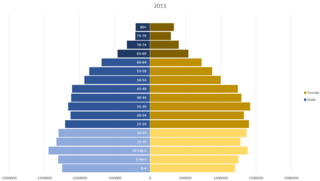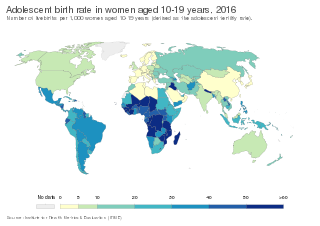This article does not cite any sources .(October 2016) (Learn how and when to remove this template message) |
These are the international rankings of Brunei
This article does not cite any sources .(October 2016) (Learn how and when to remove this template message) |
These are the international rankings of Brunei

After registering a steady increase during Soviet period, the population of Armenia declined from peak value 3.633 million in 1992 to 2.986 million in 2017.

The Republic of Ireland had a population of 4,761,865 at the 2016 census.

The population of the UK reached 68.2 million. It is the 21st most populated country in the world. It has a population density of 259 people per square kilometre, with England having significantly greater density than Wales, Scotland, and Northern Ireland. Almost a third of the population lives in England's southeast, which is predominantly urban and suburban, with about 9,000,000 in the capital city, London, whose population density is just over 5,200 per square kilometre.

Warmond is a village and former municipality in the western Netherlands, north of Leiden in the province of South Holland. The municipality covered an area of 14.42 km² of which 4.42 km² is water, and had a population of 4,977 in 2004. Together with Sassenheim and Voorhout, it became part of the Teylingen municipality on 1 January 2006. Warmond is located in an area called the "Dune and Bulb Region", and is notable for being extremely affluent.
A baby boom is a period marked by a significant increase of birth rate. This demographic phenomenon is usually ascribed within certain geographical bounds of defined national and cultural populations. People born during these periods are often called baby boomers. The cause of baby booms involves various fertility factors. The most well-known baby boom occurred in the mid-twentieth century, sometimes considered to have started after the end of the Second World War, sometimes from the late 1930s, and ending in the 1960s.

Rivne Oblast is an oblast (province) of Ukraine. Its administrative center is Rivne. The area of the region is 20,100 km²; population: 1,152,961 . Previously part of the Second Republic of Poland's Wojewódstwo Wołyńskie and earlier the Ukrainian People's Republic's Volhynian Governorate, the Rivne Oblast was created as part of the Ukrainian Soviet Socialist Republic on December 4, 1939 after the Soviet invasion and occupation of eastern Poland on 17 September 1939.

Navsari is an administrative district in the state of Gujarat in India, with its headquarters at the city of Navsari. The district covers an area of 2,211 square kilometres, and had a population of 1,329,672 in 2011. The district was formed in 1997 after Valsad district was bifurcated into Valsad and Navsari districts.

Child mortality is the mortality of children under the age of five. The child mortality rate, also under-five mortality rate, refers to the probability of dying between birth and exactly five years of age expressed per 1,000 live births.

The demography of Scotland includes all aspects of population, past and present, in the area that is now Scotland. Scotland has a population of 5,463,300, as of 2019. The population growth rate in 2011 was estimated as 0.6% per annum according to the 2011 GROS Annual Review.

Kerala is a state in south-western India. Most of Kerala's 34.8 million people are ethnically Malayalis. Most of the Malayalam and English speaking Keralites derive their ancestry from Dravidian communities that settled in Kerala. Additional ancestries derive from millennia of trade links across the Arabian Sea, whereby people of Arab, Jewish, and other ethnicities settled in Kerala. Many of these immigrants intermarried with native Malayalam speakers resulting in formation of many Christians and Muslims in Kerala. A major number of Muslims thus take lineage from Arab settlers mixed with local population.

Industrialized and developing countries have distinctly different rates of teenage pregnancy. In developed regions, such as United States, Canada, Western Europe, Australia, and New Zealand, teen parents tend to be unmarried, and adolescent pregnancy is seen as a social issue.
This is a list of New Zealand's international rankings on a range of social, economic and other criteria.

Tropical diseases, especially malaria and tuberculosis, have long been a public health problem in Kenya. In recent years, infection with the human immunodeficiency virus (HIV), which causes acquired immune deficiency syndrome (AIDS), also has become a severe problem. Estimates of the incidence of infection differ widely.
The following are international rankings of Uruguay.
According to the World Bank income level classification, Portugal is considered to be a high income country. Its population was of 10,283,822 people, by 1 July 2019. WHO estimates that 21.7% of the population is 65 or more years of age (2018), a proportion that is higher than the estimates for the WHO European Region.
The Earth has a human population of 7.8 billion, with an overall population density of 50 people per km2, excluding Antarctica. Nearly two-thirds of the world's population lives in Asia, with more than 2.7 billion in the countries of China and India combined. The world's literacy rate has increased dramatically in the last 40 years, from 66.7% in 1979 to 86.3% today. Lower literacy levels are mostly attributable to poverty. Lower literacy rates are mostly found in South Asia and Sub-Saharan Africa. The world's largest ethnic group is Han Chinese, with Mandarin being the world's most spoken language in terms of native speakers.
After a significant decline in earlier decades, crude birth rates in Armenia remained at a nearly-constant 13.0–14.2 per 1000 people in the years 1998–2015. In the same period, the crude death rate went from 8.6 to 9.3 per 1000 people. Note that crude rates are not age-adjusted. Life expectancy at birth at 74.8 years was the 4th highest among the post-USSR countries in 2014.
Latvia had the fourth highest mortality in Europe, at 704 per 100,000 population in 2015, the third highest rate of male smokers - 49%, and the second highest rate of death from injury.
In 2016 life expectancy in Uruguay for men was 73 and for women 81.
Life expectancy in Albania was estimated at 77.59 years, in 2014, ranking 51st in the world, and outperforming a number of European Union countries, such as Hungary, Poland and the Czech Republic. In 2016 it was 74 for men and 79 for women. The most common causes of death are circulatory diseases followed by cancerous illnesses. Demographic and Health Surveys completed a survey in April 2009, detailing various health statistics in Albania, including male circumcision, abortion and more.